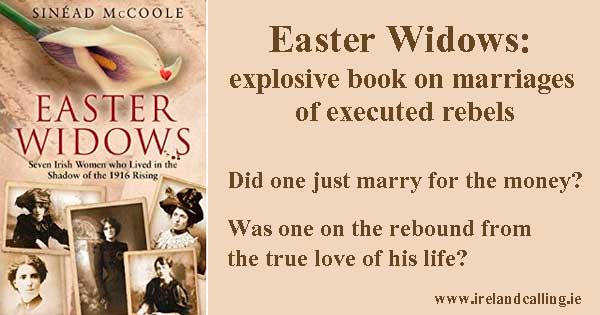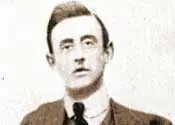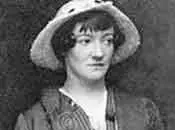Easter Widows is an explosive book that challenges the perceptions about the romantic lives of the Irish rebels executed in the Easter Rising.
The Rising was one of the key events in the history of Ireland. Easter Widows: Seven Irish Women Who Lived in the Shadow of the 1916 Rising is written by historian Sinéad McCoole, who spent two decades researching and studying the lives of the executed rebels and their wives.

The book gives fascinating insights into these relationships, and questions some of the widely believed perceptions of tragedy and romance.
For example, McCoole claims that Joseph Mary Plunkett married Grace Gifford because he was on the rebound from a Donegal woman named Columba O’Carroll, who he had chased unsuccessfully for five years. And that Plunkett’s sister believed Gifford only married him because she thought he was set to inherit his family estate.
‘It isn’t remotely what you expect’
Plunkett and Gifford were two of the leading figures of the Easter Rising. They married in Kilmainham Gaol just hours before he was executed. Theirs is possibly the most romantic and poignant love story of the Easter Rising. It was the inspiration for Jim McCann’s popular Irish ballad Grace.

However, McCoole thinks Plunkett travelled to the US and Germany on dangerous Irish Republican Brotherhood missions purposely, just to get Columba out of his head after she had repeatedly rejected his advances.
When he returned to Ireland and met Grace Gifford he thought he had found his soul mate. He thought she shared his ideals and said they would “go into the Rising together”.
McCoole, speaking to the Irish Examiner, suggested that in reality, Gifford was more interested in Plunkett’s finances. She explained: “She was no political animal. Six weeks after their prison wedding, she posed for a photograph in Chicago’s New World newspaper. She was wearing a white dress and a fancy wristwatch, holding a kitten, looking like a bohemian. It was not the mournful air of the other Easter widows in their black weeds.

“She goes down in the pantheon of Irish heroines as this great love of his life but when you research their story it isn’t remotely like what you expect it to be. When all the military-pensions material came to light, it actually showed that she was always looking for money and it was Joseph’s sister Geraldine’s opinion that Grace married him because she thought that he, as the eldest child, would inherit all the Plunkett money.”
The claims made by McCoole are in the book are far wide of the legends that surround Plunkett and Gifford.
MacBride and Gonne wanted to kill the king
There is also new light shed on the marriages of the other six women left widowed when their husbands were executed.

Maud Gonne’s rocky marriage to John MacBride is explored. McCoole agrees with the general perception that MacBride was an aggressive drunk of a husband.
What she also claims is that MacBride and Gonne travelled to Spain on their honeymoon with the intention of assassinating King Edward VII rather than spending nights of passion together. When MacBride returned to Gonne and reported that the deed had not been done, she packed her bags and stormed off to Paris.
The relationship between Tom Clarke and his wife Kathleen is also examined. Kathleen’s family were unhappy when she agreed to marry Clarke, who was more than twenty years her senior and had no financial stability or prospects. However, they were in love.
When the Rising began, Kathleen would do some gardening to try and take her mind off the danger her husband was in. She reportedly planted more than 100 cauliflowers on the first day.
McCoole explained that she prepared for writing the book by speaking to relations of the rebels and their widows, and researching historical records and newspaper accounts.
McCoole spoke at length with widow’s daughter
A letter written from prison by one of the executed rebels Michael Mallin described his pain that he would never see his infant son again: “I cannot keep the tears back when I think that he will rest in my arms no more.”
McCoole spoke at length with Mallin’s widow’s daughter Maura, who has unfortunately since passed away but gave a first-hand account of the hardships suffered by the widows after the executions.
McCoole recalled: “When I met her, her family was very bitter against the State. I couldn’t understand why she felt like that.
Now that the pension files have come to light last year, you see her mother writing from her sick-bed, asking for her money to be processed, and being told that she can’t get money for transportation. She can’t get money for books.
“Because her husband had not signed the Proclamation, she was given a reduced amount of money. Her husband was not considered to be a leader of the Rising. He was seen to have had a lesser role. Therefore, she didn’t get [enough] money, yet she was the only family member who had five children under the age of 12, being pregnant with her fifth child, Maura, who I met.
“When I realised that Maura’s mother was dead by the time Maura was 14, it made complete sense that the woman I was meeting was carrying all this resentment. Her mother had been so worried about money.”
Easter Widows: Seven Irish Women Who Lived in the Shadow of the 1916 Rising is available to buy now.
More history articles
The Neolithics – first people to leave their mark on Ireland